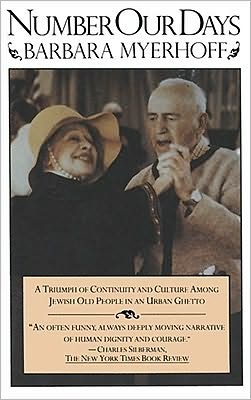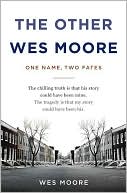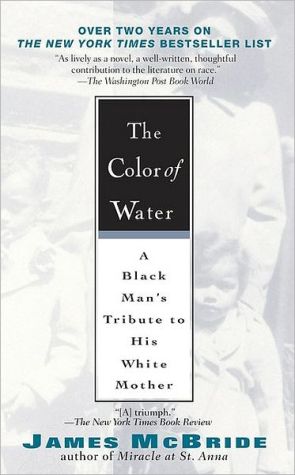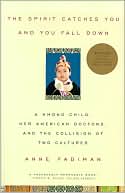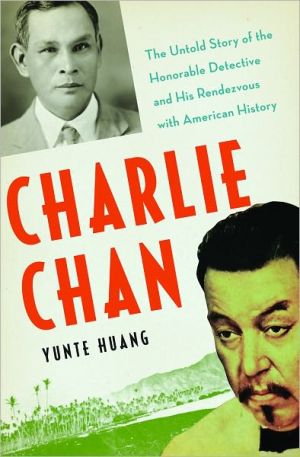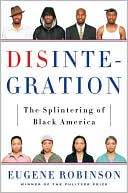Number Our Days
When noted anthropologist Barbara Myerhoff received a grant to explore the process of aging, she decided to study some elderly Jews from Venice, California, rather than to report on a more exotic people. The story of the rituals and lives of these remarkable old people is, as Bel Kaufman said, "one of those rare books that leave the reader somehow changed."\ Here Dr. Myerhoff records the stories of a culture that seems to give people the strength to face enormous daily problems — poverty,...
Search in google:
When noted anthropologist Barbara Myerhoff received a grant to explore the process of aging, she decided to study some elderly Jews from Venice, California, rather than to report on a more exotic people. The story of the rituals and lives of these remarkable old people is, as Bel Kaufman said, "one of those rare books that leave the reader somehow changed."Here Dr. Myerhoff records the stories of a culture that seems to give people the strength to face enormous daily problems — poverty, neglect, loneliness, poor health, inadequate housing and physical danger. The tale is a poignant one, funny and often wise, with implications for all of us about the importance of ritual, the agonies of aging, and the indomitable human spirit.
CHAPTER ONE\ "So what do you want from us here?"\ Every morning I wake up in pain. I wiggle my toes. Good. They still obey. I open my eyes. Good. I can see. Everything hurts but I get dressed. I walk down to the ocean. Good. It's still there. Now my day can start. About tomorrow I never know. After all, I'm eighty-nine. I can't live forever.\ Death and the ocean are protagonists in Basha's life. They provide points of orientation, comforting in their certitude. One visible, the other invisible, neither hostile nor friendly, they accompany her as she walks down the boardwalk to the Aliyah Senior Citizens' Center.\ Basha wants to remain independent above all. Her life at the beach depends on her ability to perform a minimum number of basic tasks. She must shop and cook, dress herself, care for her body and her one-room apartment, walk, take the bus to the market and the doctor, be able to make a telephone call in case of emergency. Her arthritic hands have a difficult time with the buttons on her dress. Some days her fingers ache and swell so that she cannot fit them into the holes of the telephone dial. Her hands shake as she puts in her eyedrops for glaucoma. Fortunately, she no longer has to give herself injections for her diabetes. Now it is controlled by pills, if she is careful about what she eats. In the neighborhood there are no large markets within walking distance. She must take the bus to shop. The bus steps are very high and sometimes the driver objects when she tries to bring her little wheeled cart aboard. A small boy whom she has befriended and occasionally pays often waits for her at the bus stop to help her up. When she cannot bring her cart onto the bus or isn't helped up the steps, she must walk to the market. Then shopping takes the better part of the day and exhausts her. Her feet, thank God, give her less trouble since she figured out how to cut and sew a pair of cloth shoes so as to leave room for her callouses and bunions.\ Basha's daughter calls her once a week and worries about her mother living alone and in a deteriorated neighborhood. "Don't worry about me, darling. This morning I put the garbage in the oven and the bagels in the trash. But I'm feeling fine." Basha enjoys teasing her daughter whose distant concern she finds somewhat embarrassing. "She says to me, 'Mamaleh, you're sweet but you're so stupid.' What else could a greenhorn mother expect from a daughter who is a lawyer?" The statement conveys Basha's simultaneous pride and grief in having produced an educated, successful child whose very accomplishments drastically separate her from her mother. The daughter has often invited Basha to come and live with her, but she refuses.\ What would I do with myself there in her big house, alone all day, when the children are at work? No one to talk to. No place to walk. Nobody talks Yiddish. My daughter's husband doesn't like my cooking, so I can't even help with meals. Who needs an old lady around, somebody else for my daughter to take care of? They don't keep the house warm like I like it. When I go to the bathroom at night, I'm afraid to flush, I shouldn't wake anybody up. Here I have lived for thirty-one years. I have my friends. I have the fresh air. Always there are people to talk to on the benches. I can go to the Center whenever I like and always there's something doing there. As long as I can manage for myself, I'll stay here.\ Managing means three things: taking care of herself, stretching her monthly pension of three hundred and twenty dollars to cover expenses, and filling her time in ways that have meaning for her. The first two are increasingly hard and she knows that they are battles she will eventually lose. But her free time does not weigh on her. She is never bored and rarely depressed. In many ways, life is not different from before. She has never been well-off, and she never expected things to be easy. When asked if she is happy, she shrugs and laughs. "Happiness by me is a hot cup of tea on a cold day. When you don't get a broken leg, you could call yourself happy."\ Basha, like many of the three hundred or so elderly members of the Aliyah Center, was born and spent much of her childhood in one of the small, predominately Jewish, Yiddish-speaking villages known as shtetls, located within the Pale of Settlement of Czarist Russia, an area to which almost half the world's Jewish population was confined in the nineteenth century. Desperately poor, regularly terrorized by outbreaks of anti-Semitism initiated by government officials and surrounding peasants, shtetl life was precarious. Yet a rich, highly developed culture flourished in these encapsulated settlements, based on a shared sacred religious history, common customs and beliefs, and two languages — Hebrew for prayer and Yiddish for daily life. A folk culture, Yiddishkeit, reached its fluorescence there, and though it continues in various places in the world today, by comparison these are dim and fading expressions of it. When times worsened, it often seemed that Eastern Europe social life intensified proportionately. Internal ties deepened, and the people drew sustenance and courage from each other, their religion, and their community. For many, life became unbearable under the increasingly reactionary regime of Czar Alexander II. The pogroms of 1881-1882, accompanied by severe economic and legal restrictions, drove out the more desperate and daring of the Jews. Soon they were leaving the shtetls and the cities in droves. The exodus of Jews from Eastern Europe swelled rapidly until by the turn of the century, hundreds of thousands were emigrating, the majority to seek freedom and opportunity in the New World.\ Basha dresses simply but with care. The purchase of each item of clothing is a major decision. It must last, should be modest and appropriate to her age, but gay and up-to-date. And, of course, it can't be too costly. Basha is not quite five feet tall. She is a sturdy boat of a woman — wide, strong of frame, and heavily corseted. She navigates her great monobosom before her, supported by broad hips and thin, severely bowed legs, their shape the heritage of her malnourished childhood. Like most of the people who belong to the Aliyah Center, her early life in Eastern Europe was characterized by relentless poverty.\ Basha dresses for the cold, even though she is now living in Southern California, wearing a babushka under a red sun hat, a sweater under her heavy coat. She moves down the boardwalk steadily, paying attention to the placement of her feet. A fall is common and dangerous for the elderly. A fractured hip can mean permanent disability, loss of autonomy, and removal from the community to a convalescent or old age home. Basha seats herself on a bench in front of the Center and waits for friends. Her feet are spread apart, well-planted, as if growing up from the cement. Even sitting quite still, there is an air of determination about her. She will withstand attacks by anti-Semites, Cossacks, Nazis, historical enemies whom she conquers by outliving. She defies time and weather (though it is not cold here). So she might have sat a century ago, before a small pyramid of potatoes or herring in the marketplace of the Polish town where she was born. Patient, resolute, she is a survivor.\ Not all the Center women are steady boats like Basha. Some, like Faegl, are leaves, so delicate, dry, and vulnerable that it seems at any moment they might be whisked away by a strong gust. And one day, a sudden wind did knock Faegl to the ground. Others, like Gita, are birds, small and sharp-tongued. Quick, witty, vain, flirtatious, they are very fond of singing and dancing. They once were and will always be pretty girls. This is one of their survival strategies. Boats, leaves, or birds, at first their faces look alike. Individual features are blurred by dentures, heavy bifocals, and webs of wrinkles. The men are not so easy to categorize. As a group, they are quieter, more uniform, less immediately outstanding except for the few who are distinctive individuals, clearly distinguishable as leaders.\ As the morning wears on, the benches fill. Benches are attached back to back, one side facing the ocean, one side the boardwalk. The people on the ocean side swivel around to face their friends, the boardwalk, and the Center.\ Bench behavior is highly stylized. The half-dozen or so benches immediately to the north and south of the Center are the territory of the members, segregated by sex and conversation topic. The men's benches are devoted to abstract, ideological concerns — philosophical debate, politics, religion, and economics. The women's benches are given more to talk about immediate, personal matters — children, food, health, neighbors, love affairs, scandals, and "managing." Men and women talk about Israel and its welfare, about being a Jew and about Center politics. On the benches, reputations are made and broken, controversies explored, leaders selected, factions formed and dissolved. Here is the outdoor dimension of Center life, like a village plaza, a focus of protracted, intense sociability.\ The surrounding scene rarely penetrates the invisible, pulsing membrane of the Center community. The old people are too absorbed in their own talk to attend the setting. Surfers, sunbathers, children, dogs, bicyclists, winos, hippies, voyeurs, photographers, panhandlers, artists, junkies, roller skaters, peddlers, and police are omnipresent all year round. Every social class, age, race, and sexual preference is represented. Jesus cults, Hare Krishna parades, sidewalk preachers jostle steel bands and itinerant musicians. As colorful and flamboyant as the scene is by day, it is as dangerous by night. Muggings, theft, rape, harassment, and occasional murders make it a perilous neighborhood for the old people after dark.\ Farther up the boardwalk other elderly Jews stake out their territory on benches and picnic tables used for chess, pinochle, poker, and Mah-Jongg. The Center members do not regard them as "serious" or "cultured" people, while they, in turn, consider the Center elderly too political or religious, too inclined to be "joiners," for their taste. Still other old Jews periodically appear on the boardwalk selling Marxist periodicals, Socialist tracts, collecting money for Mexican laborers, circulating petitions to abolish capital punishment. For them, the Center people are too politically conservative. All the elderly Jews in the neighborhood are Eastern European in origin. All are multilingual. Hebrew is brought out for punctuating debates with definitive learned points, usually by the men. Russian or Polish are more used for songs, stories, poems, and reminiscences. But Yiddish binds these diverse people together, the beloved mama-loshen of their childhood. It is Yiddish that is used for the most emotional discussions. Despite their ideological differences, most of these people know each other well, having lived here at the beach for two and three decades.\ Signs of what was once a much larger, more complete Yiddish ghetto remain along the boardwalk. Two storefront synagogues are left, where only a few years ago there were a dozen. There is a delicatessen and a Jewish bakery. Before there were many kosher butcher stores and little markets. Only three Jewish board-and-care homes and four large hotels are left to house the elderly. The four thousand or so elderly Jews in the neighborhood must find accommodations in small, rented rooms and apartments within walking distance of the Center. A belt, roughly five miles long and a mile wide, constitutes the limits of the effective community of these Eastern European immigrants, nearly all of whom are now in their middle eighties and up. Several special organizations in the area meet some of their present needs — a secular senior citizen club operated by the city, an outreach city- and state-funded social service center, a women's private political-cultural club, a hot-meals-for-the-elderly service held at a local school. At the edge of the community, still within walking distance of the Center, are several expensive apartments and board-and-care homes (known as "residential facilities"); these accommodate the handful of members who are relatively well-off.\ A decade ago, census figures suggest that as many as ten thousand elderly Eastern European Jews lived in the neighborhood. Then Yiddish culture flourished. Groups such as the Workmen's Circle, Emma Lazarus Club, women's philanthropic and religious organizations, various Zionist and Socialist groups were plentiful. Poetry and discussion groups often met in people's homes. There was a dance hall and a choral society. Then, it was said that the community had "the schonste Yiddishkeit outside of New York." Around thirty years ago, Jews from all over the country began to immigrate to the beach community, particularly those with health problems and newly retired. Seeking a benign climate, fellow Jews, and moderately priced housing, they brought their savings and small pensions and came to live near the ocean. Collective life was and still is especially intense in this community because there is no automobile traffic on the boardwalk. Here is a place where people may meet, gather, talk, and stroll, simple but basic and precious activities that the elderly in particular can enjoy here all year round.\ In the late 1950s, an urban development program resulted in the displacement of between four and six thousand of these senior citizens in a very short period. It was a devastating blow to the culture. "A second Holocaust," Basha called it. "It destroyed our shtetl life all over again. Soon after the urban development project began, a marina was constructed at the southern end of the boardwalk. Property values soared. Older people could not pay taxes and many lost their homes. Rents quadrupled. Old hotels and apartments were torn down, and housing became the single most serious problem for the elderly who desperately wanted to remain in the area. While several thousand have managed to hang on, no new members are moving into the area because of the housing problem. Their Yiddish world, built up over a thirty-year period, is dying and complete extinction is imminent. Perhaps it will last another five or at the most ten years. Whenever a Center member leaves, everyone is acutely aware that there will be no replacements. The sense of cultural doom coincides with awareness of approaching individual death. "When I go out of here, it will be in a box or to the old folks' home. I couldn't say which is worse," Basha said. "We've only got a few more years here, all of us. It would be good if we could stay till the end. We had a protest march the other day, when they took down the old Miramar Hotel. I made up a sign. It said, 'Let my people stay.'"\ Yet the community is not a dreary place and the Center members not a depressed group. The sense of doom, by some miraculous process, functions to heighten and animate their life. Every moment matters. There is no time for deception, trivia, or decorum. Life at the Center is passionate, almost melodramatic. Inside, ordinary concerns and mundane interchanges are strangely intense, quickly heating to outburst. The emotional urgency often seems to have little to do with content. This caldronlike quality is perhaps due to the elders' proximity to death and the realization that their remaining days are few. They want to be seen and heard from, before it is too late. Fiercely, they compete with each other for limited supplies of time and attention. Perhaps it is due to the members' extreme dependence on each other; though strongly attached, they are ambivalent about living so closely with others brought into contact with them more by circumstance than choice. Perhaps it is because these elderly people enjoy the strong flood of energy and adrenaline released in intense interactions, assuring them that they are still alive and active.\ In spite of its isolation, the beach community is well-known in the city, primarily because of its ethnic distinctiveness and longevity. It is small, stable, cohesive, delimited, and homogeneous in terms of the people's cultural and historical background, an urban ghetto — closed, encapsulated, and self-contained. Relations between the older beach citizens and the broader urban and Jewish worlds are attenuated and episodic. Periodically, various charitable organizations and synagogues offer the Center services and aid, for it is well-known that the majority of old people are isolated and living on small, fixed incomes, below national poverty levels. But Center folk are not easy people to help. Pride and autonomy among them are passions. They see themselves as givers, not takers, and devote enormous effort toward supporting others more needy than they, particularly in Israel. These elders, with few exceptions, are cut off from their family and children. From time to time, relatives visit them or take them back to their homes for holidays or to spend the night, but on a day-to-day basis, the old people effectively are on their own. They miss their family but cherish their independence.\ As the numbers of such people shrink and the neighborhood changes, the Aliyah Center becomes more and more important to its members. Sponsored by a city-wide philanthropic Jewish organization, it is maintained as a day center that emphasizes "secular Judaism." Officially, about three hundred members pay dues of six dollars a year, but these figures do not reflect the actual importance of the Center to the community. Many more use it than join, and they use it all day, every day. The Center is more halfway house than voluntary association, making it possible for hundreds of people to continue living alone in the open community, despite their physical and economic difficulties. Daily hot meals are provided there, and continuous diverse programs are offered — cultural events, discussions, classes of all kinds, along with social affairs, religious ceremonies, celebrations of life crises, anniversaries, birthdays, memorials, and occasional weddings. The gamut of political and social processes found in larger societies are well-developed in Center life. Here is an entire, though miniature, society, a Blakeian "world in a grain of sand," the setting for an intricate and rich culture, made up of bits and pieces of people's common history.\ Center culture is in some respects thin and fragile, but its very existence must be seen as a major accomplishment, emerging spontaneously as a result of two conditions that characterize the members: continuities between past and present circumstance, and social isolation. Several marked similarities existed between the circumstances of members' childhood and old age. They had grown up in small, intimate Jewish communities, cohesive, ethnocentric, surrounded by indifferent and often hostile outsiders. Previously, in Eastern Europe, they had been marginal people, even pariahs, as they were now. They had strong early training in resourcefulness and opportunities to develop sound survival strategies. Then, as now, they had been poor, politically impotent, and physically insecure. Then, as now, they turned to each other and their shared Yiddishkeit for sustenance, constituting what Irving Howe has called a "ragged kingdom of the spirit." It was not a great shock for these people to find themselves once more in difficult circumstances, for they had never given up their conviction that life was a struggle, that gains entailed losses, that joy and sorrow were inseparable. They knew how to pinch pennies, how to make do, and how to pay attention to those worse off than they and thereby feel useful and needed. They had come to America seeking another life and found that it, too, provided some fulfillments, some disappointments. And thus, they were now not demoralized or helpless.\ Their culture was able to emerge as fully as it did because of the elders' isolation from family and the outside world, ironically, the very condition that causes them much grief. Yet, by this separation, they were freed to find their own way, just as their children had been. Now they could indulge their passion for things of the past, enjoy Yiddishkeit without fear of being stigmatized as "not American." With little concern for public opinion, with only each other for company, they revitalized selected features of their common history to meet their present needs, adding and amending it without concern for consistency, priority, or "authenticity." It had taken three decades for this culture to develop to its present state of complexity, now a truly organic, if occasionally disorderly and illogical amalgam of forms and sentiments, memories and wishes, rotating around a few stable, strong symbols and premises. Claude Lévi-Strauss had used the word bricolage to describe the process through which myths are constructed in preliterate societies. Odds and ends, fragments offered up by chance or the environment — almost anything will do — are taken up by a group and incorporated into a tale, used by a people to explain themselves and their world. No intrinsic order or system has dictated the materials employed. In such an inelegant fashion does the bricoleur or handyman meet his needs.\ Center culture was such a work of bricolage. Robust and impudently eclectic, it shifted and stretched to meet immediate needs — private, collective, secular, and sacred. Thus, when a Center Yiddish History class graduated, a unique ceremony was designed that pasted together the local event with an analogous, historical counterpart, thereby enlarging and authenticating the improvised, contemporary affair. And the traditional Sabbath ceremony was rearranged to allow as many people as possible to participate — making speeches, singing songs, reading poems, taking into account the members' acute need for visibility and attention. Among them, two or even three women instead of one were required to light the Sabbath candles — one singing the blessing in Hebrew, one in Yiddish, one putting the match to the wick. Similarly, Center folk redefined the secular New Year's Eve, holding their dance a full day and a half before the conventional date, since this made it possible for them to get home before dark and to hire their favorite musicians at lower rates. These improvisations were entirely authentic. Somehow midday December 30 became the real New Year's Eve and the later, public celebration seemed unconvincing by comparison. In all this no explicit plan or internal integration could be detected. Cultures are, after all, collective, untidy assemblages, authenticated by belief and agreement, focused only in crisis, systematized after the fact. Like a quilt, Center life was made up of many small pieces sewn together by necessity, intended to be serviceable and to last. It was sufficient for the people's remaining years.\ The vitality and flexibility of the Center culture was especially impressive in view of the organization's meager budget. Enough money was available only to pay for a few programs and the salary of the director, Abe, who had devoted himself to these elderly people for fourteen years. Sometimes he was a surrogate son, sometimes a worrying, scolding, protecting parent to them. Thirty years younger than most members, Abe was a second-generation American, from the same background as they. A social worker by training, he watched over the elders' health, listened to their complaints, mediated their quarrels, teased and dominated them when they lost heart, and defended them against external threats, insisting to them and the outside world that they survive. Without his dedication, it was unlikely that they would have been able to continue for so long and so well, living alone into advanced old age in an open, inhospitable setting.\ I sat on the benches outside the Center and thought about how strange it was to be back in the neighborhood where sixteen years before I had lived and for a time had been a social worker with elderly citizens on public relief. Then the area was known as "Oshini Beach." The word shini still made me cringe. As a child I had been taunted with it. Like many second-generation Americans, I wasn't sure what being a Jew meant. When I was a child our family had avoided the words Jew and Yid. We were confused and embarrassed about our background. In public we lowered our voices when referring to "our people" or "one of us." My grandparents had also emigrated from an Eastern European shtetl as young people. Like so many of the Center folk, they, too, wanted their children to be Americans above all and were ashamed of being "greenhorns." They spoke to my parents in Yiddish and were answered in English. None of the children or grandchildren in the family received any religious education, yet they carried a strong if ambivalent identity as Jews. This identity took the form of fierce pride and defensiveness during the Holocaust, but even then did not result in any of us developing a clear conception of how to live in terms of our ethnic membership.\ I had made no conscious decision to explore my roots or clarify the meaning of my origins. I was one of several anthropologists at the University of Southern California engaged in an examination of Ethnicity and Aging. At first I planned to study elderly Chicanos, since I had previously done fieldwork in Mexico. But in the early 1970s in urban America, ethnic groups were not welcoming curious outsiders, and people I approached kept asking me, "Why work with us? Why don't you study your own kind?" This was a new idea to me. I had not been trained for such a project. Anthropologists conventionally investigate exotic, remote, preliterate societies. But such groups are increasingly unavailable and often inhospitable. As a result, more and more anthropologists are finding themselves working at home these days. Inevitably, this creates problems with objectivity and identification, and I anticipated that I, too, would have my share of them if I studied the Center folk. But perhaps there would be advantages. There was no way that I could have anticipated the great impact of the study on my life, nor its duration. I intended to spend a year with them. In fact, I was with them continuously for two years (1973-1974, 1975-1976) and periodically for two more. In the beginning, I spent a great deal of time agonizing about how to label what I was doing — was it anthropology or a personal quest? I never fully resolved the question. I used many conventional anthropological methods and asked many typical questions, but when I had finished, I found my descriptions did not resemble most anthropological writings. Still, the results of the study would certainly have been different had I not been an anthropologist by training.\ Sitting in the sun and contemplating the passing parade on the boardwalk that morning in 1973, I wondered how I should begin this study. At eleven-thirty the benches began to empty as old people entered the Center for a "Hot Kosher Meal — Nutritious — 65¢," then a new program provided by state and private funds. Inside there was barely enough room to accommodate between 100 and 150 people who regularly ate there. The Center was only a simple, shabby hall, the size of a small school auditorium, empty except for a tiny stage at one end with a kitchen behind it, and a little area partitioned off at the other end, used for a library and office. The front window was entirely covered by hand-lettered signs in Yiddish and English announcing current events:\ TODAY AT 2:00\ Jewish History Class. — Teacher, Clara Shapiro\ Very educational.\ SUNDAY AT 1:00\ Special Event: Films on Israel\ Refreshments. Come. Enjoy.\ MONDAY AT 3:00\ Gerontology Class. — Teacher, Sy Greenberg.\ Informative. Bring your questions.\ TUESDAY AT 10:00\ Rabbi Cohen talks on Succoth.\ Beautiful and enlightening.\ \ Over the front door hung another handmade sign, written and painted by one of the members: "To the extent that here at the Center we are able to be ourselves and to that extent Self feels good to us." The walls were adorned with pictures of assorted Yiddish writers, scholars, and Zionists. Two large colored photographs of the Western Wall in Jerusalem and of Golda Meir hung above a bust of Moshe Dayan. Seniors' arts and crafts were displayed in a glass case. Their paintings and drawings hung along one wall, depicting shtetl scenes and household activities associated with sacred rituals — the lighting of the Sabbath candles, the housewife baking the Sabbath loaf, a father teaching his children their religious lessons, and the like. Portraits of rabbis, tailors, scholars hung there, too, along with symbols of Jewish festivals and holidays — a papier-mâché dreidel, and cardboard menorah, a shofar. A large, wooden Star of David illuminated by a string of Christmas tree lights was prominently displayed. Framed certificates of commendation and thanks from Israeli recipients of the elders' donations hung alongside photographs of kibbutzim children to whom the Center elders had contributed support. The wall opposite bore a collective self-portrait in the form of a room-length mural, designed and painted by the members, portraying their common journey from the past to the present in several colorful, strong, and simple scenes: a picture of a boatload of immigrants arriving at Ellis Island, a Shtetl marketplace, a New York street scene, a shtetl street scene, and a group of picketers bearing signs, "Better Conditions First," "We Shall Fight for Our Rights," "Power and Justice for the People," and one that simply said, "Protest Treatment." The last sequence rendered the elders at present, seated on benches along the boardwalk and celebrating the Sabbath inside the Center. Over the small stage, the line from the Old Testament was lettered, "Behold How Good It Is for Brethren to Dwell Together in Unity," and opposite, a prominent placard that read, "Cast Me Not Out in My Old Age But Let Me Live Each Day as a New Life." More than decoration, these visual displays were the people's icons, constituting a symbolic depiction — the group's commentary on itself — by reference to its sources of identity, in particular, its common history. This use of symbols pointed to a community that was highly conscious of itself and its own distinctive ideology.\ I followed the crowd inside and sat at the back of the warm, noisy room redolent with odors of fish and chicken soup, wondering how to introduce myself. It was decided for me. A woman sat down next to me who I soon learned was Basha. In a leisurely fashion, she appraised me. Uncomfortable, I smiled and said hello.\ "You are not hungry?" she asked.\ "No, thank you, I'm not," I answered.\ "So, what brings you here?"\ "I'm from the University of Southern California. I'm looking for a place to study how older Jews live in the city."\ At the word university, she moved closer and nodded approvingly. "Are you Jewish?" she asked.\ "Yes, I am."\ "Are you married?" she persisted.\ "Yes."\ "You got children?"\ "Yes, two boys, four and eight," I answered.\ "Are you teaching them to be Jews?"\ "I'm trying."\ "So what do you want with us here?" asked Basha.\ "Well, I want to understand your life, find out what it's like to be older and Jewish, what makes Jews different from other older people, if anything. I
CONTENTSACKNOWLEDGMENTSFOREWORD by Victor Turner1. "So what do you want from us here?"2. Needle and thread: the life and death of a tailor3. "We don't wrap herring in a printed page"4. "For an educated man, he could learn a few things"5. "We fight to keep warm"6. Teach us to number our days7. "Jewish comes up in you from the roots"EPILOGUEAFTERWORDNOTESREFERENCESINDEX
